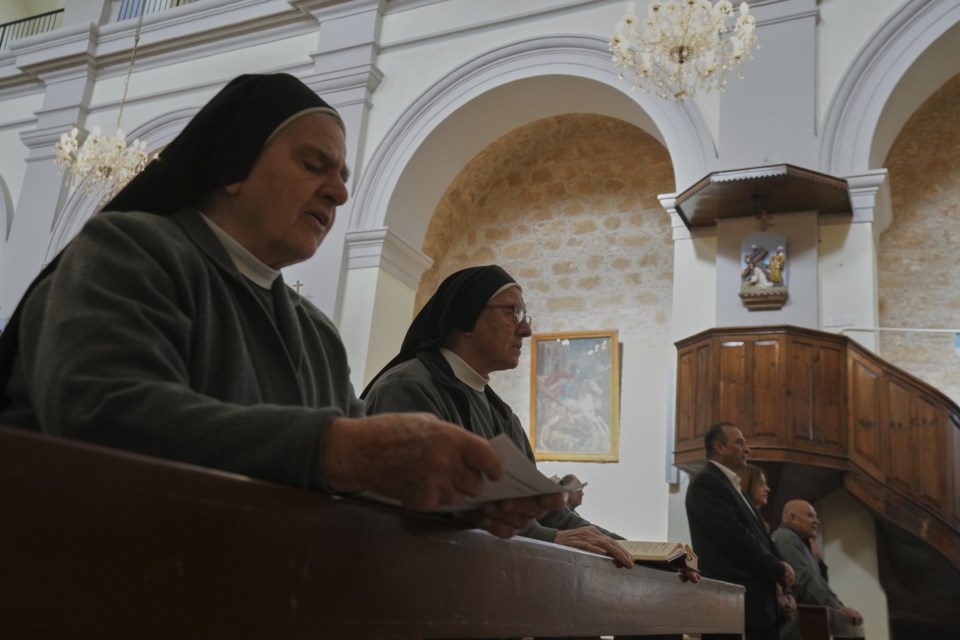KORMAKITIS, Cyprus (AP) — Ash dangled precariously from Iosif Skordis' cigarette as he reminisced with fellow villagers in a language on the edge of extinction, one that partly traces its roots to the language Jesus Christ once spoke.
The 97-year-old Skordis is one of only 900 people in the world who speak Cypriot Maronite Arabic, or Sanna. Today, his village of Kormakitis is the last bastion of a language once spoken by tens of thousands of people across dozens of villages.
The tongue, an offshoot of Syrian Arabic that has absorbed some Greek, has been passed from generation to generation in this windswept community in Cyprus. Until less than two decades ago, there was no written script, or even an alphabet, since parents transmitted it to children in conversation. Only a handful of people are trained to teach it.
Sanna is at risk of disappearing, according to the Council of Europe’s minority language experts. One Indigenous language dies every two weeks, the United Nations estimates, diminishing the tapestry of human knowledge one strand at a time.
But the 7,500-strong Maronite community in Cyprus is pushing back. With help from the Cypriot government and the European Union, it has built schools, created a Sanna alphabet to publish textbooks and begun classes to keep the language alive and thriving.
“Sanna … is undoubtedly one of the most distinguishing features of our cultural identity,” said Yiannakis Moussas, the Maronite community’s representative in the Cypriot legislature. He spoke in the Kormakitis coffeehouse adorned with soccer trophies and banners emblazoned with a Lebanese cedar.
“And it’s striking evidence of our heritage. The fact that we speak a kind of Arabic over so many centuries makes it clear that we descend from areas of Syria and Lebanon.”
Roots in Syria and Lebanon
The language was brought to Cyprus by waves of Arab Christians fleeing persecution by invading Arab Muslim fighters in what is now Syria, Lebanon and Israel, starting as early as the 8th century.
Sanna at its root is a semitic language that, unlike other Arabic dialects, contains traces of the Aramaic that was spoken by populations prior to the Arab invasion of the Levant, according to University of Cyprus linguistics professor Marilena Kariolemou, who leads the team responsible for the language’s revitalization.
That’s because the Maronite community in Cyprus was isolated from other Arabic-speaking populations.
But as Maronites increasingly interacted with the island’s majority Greek-speaking population and became bilingual, Sanna evolved to incorporate several Greek words, adding to its uniqueness among the many Arabic dialects.
According to Kariolemou, Sanna contains five vowels similar to Greek and another three similar to Aramaic, while consonants whose sounds are formed in the back of the throat have diminished, likely because of the Greek influence. Sanna also adopted Greek syntax, she said.
The effects of a Turkish invasion
Until the mid-1970s, the Maronite community was largely centered around four villages: Asomatos, Ayia Marina, Karpasia and Kormakitis as the cultural center.
But the 1974 Turkish invasion that split into a breakaway Turkish Cypriot north and a Greek Cypriot south, where the internationally recognized government is based, saw most Maronites dispersed throughout the south.
Asomatos and Ayia Marina are empty of Maronite inhabitants and are now Turkish army camps.
Moussas, the community representative, said the consequences of 1974 were “catastrophic” for the Maronites as they gravitated toward the island’s major cities, putting their culture and language at risk as children attended Greek-speaking schools and intermarriage with Greek Cypriots increased.
It’s said that currently, only one in five Maronite marriages are between members of the community.
A hope for revival
That left Kormakitis as the linguistic “hive” for Cypriot Maronite Arabic, only spoken by residents over 50, according to retired teacher Ilias Zonias. Born in Kormakitis, Zonias is the only native Sanna speaker qualified to teach the language.
Kormakitis was a closed society in which residents spoke Sanna, while their kids went to school not knowing Greek. That’s how the language was preserved, Zonias said.
Still, speakers after 1974 began to dwindle until around the turn of the millennium, when the Maronite community with the help of the Cypriot government increased efforts to save the language.
Cyprus’ 2004 membership in the EU was a milestone for Sanna as the bloc poured resources into safeguarding Indigenous minority languages, a designation that Cypriot authorities had bestowed.
Kariolemou said her team in 2013 set up a recorded archive of spoken Sanna, some 280 hours long, for further study.
A 27-letter alphabet was created in mostly Latin characters, thanks mainly to the work of linguist Alexander Borg. Grammar was formulated and refined, enabling the publication of books for teaching Sanna.
Efforts to attract young families
Language courses are in their early stages, Skordis said, with about 100 children and adults in classes in Kormakitis and the Saint Maronas primary school in Lakatamia, a suburb of Nicosia, the country's capital. A summer language camp for children and adults in Kormakitis has also been created.
An initiative is underway for native-born speakers — primarily Kormakitis residents — to learn how to teach Sanna.
At Ayios Maronas primary school, 20 kindergarten-age children are learning the language with books containing QR codes that can be scanned so students can follow an audio adaptation on school-provided tablets.
But for Sanna to have a real future, there is no substitute for young families returning in large numbers to Kormakitis, where the language can be taught in the newly built, EU-funded school, Moussas said.
Community leaders, however, aren’t pleased with the low number of people expressing interest. Moussas said community leaders and the Cypriot government are looking into offering incentives, primarily to make it easier to find housing.
For Zonias, keeping the language alive for the ages would be the crowning achievement of his career.
“I don’t want to be the last teacher of Sanna,” he said.
Menelaos Hadjicostis, The Associated Press



